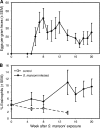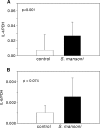Coinfection with Schistosoma mansoni reactivates viremia in rhesus macaques with chronic simian-human immunodeficiency virus clade C infection
- PMID: 17283092
- PMCID: PMC1865689
- DOI: 10.1128/IAI.01703-06
Coinfection with Schistosoma mansoni reactivates viremia in rhesus macaques with chronic simian-human immunodeficiency virus clade C infection
Abstract
We tested the hypothesis that helminth parasite coinfection would intensify viremia and accelerate disease progression in monkeys chronically infected with an R5 simian-human immunodeficiency virus (SHIV) encoding a human immunodeficiency virus type 1 (HIV-1) clade C envelope. Fifteen rhesus monkeys with stable SHIV-1157ip infection were enrolled into a prospective, randomized trial. These seropositive animals had undetectable viral RNA and no signs of immunodeficiency. Seven animals served as virus-only controls; eight animals were exposed to Schistosoma mansoni cercariae. From week 5 after parasite exposure onward, coinfected animals shed eggs in their feces, developed eosinophilia, and had significantly higher mRNA expression of the T-helper type 2 cytokine interleukin-4 (P = 0.001) than animals without schistosomiasis. Compared to virus-only controls, viral replication was significantly increased in coinfected monkeys (P = 0.012), and the percentage of their CD4(+) CD29(+) memory cells decreased over time (P = 0.05). Thus, S. mansoni coinfection significantly increased viral replication and induced T-cell subset alterations in monkeys with chronic SHIV clade C infection.
Figures




Similar articles
-
Schistosoma mansoni infection promotes SHIV clade C replication in rhesus macaques.AIDS. 2005 Nov 4;19(16):1793-7. doi: 10.1097/01.aids.0000189857.51935.0b. AIDS. 2005. PMID: 16227786
-
Schistosoma mansoni enhances host susceptibility to mucosal but not intravenous challenge by R5 Clade C SHIV.PLoS Negl Trop Dis. 2011 Aug;5(8):e1270. doi: 10.1371/journal.pntd.0001270. Epub 2011 Aug 2. PLoS Negl Trop Dis. 2011. PMID: 21829749 Free PMC article.
-
Acute Schistosoma mansoni infection increases susceptibility to systemic SHIV clade C infection in rhesus macaques after mucosal virus exposure.PLoS Negl Trop Dis. 2008 Jul 23;2(7):e265. doi: 10.1371/journal.pntd.0000265. PLoS Negl Trop Dis. 2008. PMID: 18648516 Free PMC article.
-
V3 loop-determined coreceptor preference dictates the dynamics of CD4+-T-cell loss in simian-human immunodeficiency virus-infected macaques.J Virol. 2005 Oct;79(19):12296-303. doi: 10.1128/JVI.79.19.12296-12303.2005. J Virol. 2005. PMID: 16160156 Free PMC article.
-
Viral burden and disease progression in rhesus monkeys infected with chimeric simian-human immunodeficiency viruses.Virology. 1999 Mar 30;256(1):15-21. doi: 10.1006/viro.1999.9632. Virology. 1999. PMID: 10087222
Cited by
-
Assessment of schistosomiasis endemicity and preventive treatment on coronavirus disease 2019 outcomes in Africa.New Microbes New Infect. 2020 Nov;38:100821. doi: 10.1016/j.nmni.2020.100821. Epub 2020 Nov 21. New Microbes New Infect. 2020. PMID: 33251016 Free PMC article.
-
Immune-based approaches to the prevention of mother-to-child transmission of HIV-1: active and passive immunization.Clin Perinatol. 2010 Dec;37(4):787-805, ix. doi: 10.1016/j.clp.2010.08.005. Clin Perinatol. 2010. PMID: 21078451 Free PMC article.
-
Passive immunization of macaques with polyclonal anti-SHIV IgG against a heterologous tier 2 SHIV: outcome depends on IgG dose.Retrovirology. 2014 Jan 20;11:8. doi: 10.1186/1742-4690-11-8. Retrovirology. 2014. PMID: 24444350 Free PMC article.
-
Effects of parasites coinfection with other pathogens on animal host: A literature review.Vet World. 2022 Oct;15(10):2414-2424. doi: 10.14202/vetworld.2022.2414-2424. Epub 2022 Oct 15. Vet World. 2022. PMID: 36425132 Free PMC article. Review.
-
Novel Strategy To Adapt Simian-Human Immunodeficiency Virus E1 Carrying env from an RV144 Volunteer to Rhesus Macaques: Coreceptor Switch and Final Recovery of a Pathogenic Virus with Exclusive R5 Tropism.J Virol. 2018 Jun 29;92(14):e02222-17. doi: 10.1128/JVI.02222-17. Print 2018 Jul 15. J Virol. 2018. PMID: 29743361 Free PMC article.
References
-
- Ahmed-Ansari, A., J. D. Powell, P. E. Jensen, T. Yehuda-Cohen, H. M. McClure, D. Anderson, P. N. Fultz, and K. W. Sell. 1990. Requirements for simian immunodeficiency virus antigen-specific in vitro proliferation of T cells from infected rhesus macaques and sooty mangabeys. AIDS 4:399-407. - PubMed
-
- Ayash-Rashkovsky, M., Z. Bentwich, and G. Borkow. 2005. TLR9 expression is related to immune activation but is impaired in individuals with chronic immune activation. Int. J. Biochem. Cell Biol. 37:2380-2394. - PubMed
-
- Baba, T. W., Y. S. Jeong, D. Pennick, R. Bronson, M. F. Greene, and R. M. Ruprecht. 1995. Pathogenicity of live, attenuated SIV after mucosal infection of neonatal macaques. Science 267:1820-1825. - PubMed
-
- Baba, T. W., V. Liska, A. H. Khimani, N. B. Ray, P. J. Dailey, D. Penninck, R. Bronson, M. F. Greene, H. M. McClure, L. N. Martin, and R. M. Ruprecht. 1999. Live attenuated, multiply deleted simian immunodeficiency virus causes AIDS in infant and adult macaques. Nat. Med. 5:194-203. - PubMed
Publication types
MeSH terms
Substances
Grants and funding
LinkOut - more resources
Full Text Sources
Research Materials

